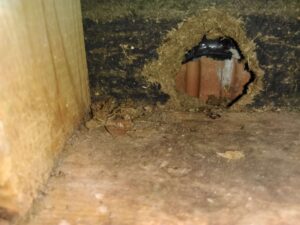How vulnerable is your home to rodent infestations? People like to assume a sound structure and durable building materials prevent wildlife from entering their property, but these barriers are only as strong as the prescribed maintenance routine. Many building components are surprisingly vulnerable to rodents, making a rat removal service in Milwaukee especially necessary.
Bricks, wood, improperly cured concrete, and walls are not generally impenetrable to rats. Between the incessant need to file down teeth and unbelievable bite strength, rats can be invasive and incredibly persistent when motivated. Thankfully, prevention is possible, ensuring the safety of your home.
The Growth Rate of Teeth and the Life-Saving Need To Chew
A rat does not chew out of pure enjoyment, and despite what some might assume, it does not always chew for nesting or feeding. A rat’s teeth grow at an exponential rate, roughly 1.4 mm per day. If the animal does not continually chew to file down its teeth, its chompers will eventually grow through its skull, potentially leading to infection and possible death.
While many see chewing as an obnoxious characteristic of rats and other rodents, it is essential to their survival. The animals are not deliberately trying to annoy their human neighbors. However, regardless of the intent, the constant chewing can cause significant problems, especially when the rodent gnaws inside your walls and home.
A rat does not have the ability to differentiate between what can and cannot be chewed. If the animal makes it into your walls or attic, the critter will likely begin munching on structural components and wiring. If there are enough rats in these spaces, the likelihood of fires or expensive structural damage increases dramatically.
The Seemingly Impossible Jaw Strength of this Unimposing Mammal
 Beyond the inherent need to chew, people are often astonished by the overwhelming jaw strength of rats. While it is difficult to get a precise measurement for comparison, most wildlife experts speculate a rat can exert about 12 tons of pressure per square inch; that is 24,000 pounds. If that is not amazing enough, consider their bite strength is greater than that of alligators or great white sharks.
Beyond the inherent need to chew, people are often astonished by the overwhelming jaw strength of rats. While it is difficult to get a precise measurement for comparison, most wildlife experts speculate a rat can exert about 12 tons of pressure per square inch; that is 24,000 pounds. If that is not amazing enough, consider their bite strength is greater than that of alligators or great white sharks.
Given these facts, it is easy to imagine how most building materials do not stand a chance against a motivated rat. However, it is possible to demotivate a rodent or prevent gnawing altogether. A good way to avoid or resolve rat problems is to begin by thwarting ease of access.
The Possibility of Prevention and Expulsion Using a Rat Removal Service
While a rat can chew through the exterior of your home or building, depending on the materials, it prefers a path of least resistance. By inspecting your property, primarily around vulnerable entry points such as soffits, windows and doors, and ensuring there are no cracks, holes, or openings, you already win half the battle.
You also need to eliminate any motivation for the animal, which includes food, water, and shelter. If you have pets, keep their food inside and covered when they are not eating. If you put bird feeders on your property, keep them away from the structure of your home. Make sure that any outdoor faucets and hoses are turned all the way off. Finally, try and refrain from planting shrubs, bushes, or other vegetation within three to four feet of your house or building.
If you suspect you already have a rodent problem, you can reach out to a wildlife removal service to aid in the humane expulsion of the species. Remember, rats are not intentionally trying to harm your home; they only want to survive. Contact an expert with Skedaddle Humane Wildlife Control in Milwaukee to assess your property and provide a rodent removal or prevention solution.




